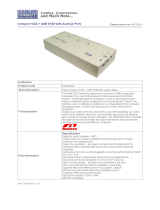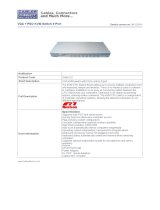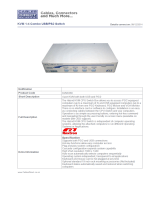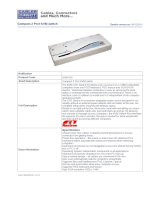Page is loading ...

User Manual
F1DS102L
F1DS104L
OmniView
®
SOHO KVM
Switch with Audio
VGA with USB Console and Host Support

Table of Contents
1. Introduction ............................................................................... 1
Package Contents ...........................................................1
2. Overview .................................................................................... 2
Feature Overview .............................................................2
Equipment Requirements .................................................3
Unit Display Diagrams ......................................................4
Specifications ..................................................................5
3. Installing the KVM Switch ........................................................... 6
Pre-Configuration ............................................................6
Connecting the KVM Switch .............................................7
Audio and Microphone Connections .................................8
Powering Up the Systems ................................................9
4. Using the KVM Switch ............................................................... 10
Selecting a Computer Using Direct-Access Port Selectors ............ 10
Selecting a Computer Using Keyboard Hot-Key Commands .........10
Hot-Key Preceding Sequence Configuration .............................11
Hot Key Quick Reference Table .............................................12
Switching the Audio/Mic ...................................................... 13
5. Firmware-Upgrade Guide ......................................................... 14
Upgrade Using the Windows Version Utility ..................... 14
Upgrade Using the Mac Version Utility ............................ 18
6. FAQs ......................................................................................... 24
7. Troubleshooting ....................................................................... 26
Firmware-Upgrade Troubleshooting ................................ 30
8. Information .............................................................................. 31

11
1
2
3
4
5
6
7
8
section
Introduction
Congratulations on your purchase of the Belkin OmniView SOHO KVM Switch with
Audio. Our diverse line of quality KVM solutions exemplifies the Belkin commitment
to delivering high-quality, durable products at a competitive price. Engineered to
give you control over multiple computers/servers from one console, Belkin KVM
Switches come in a variety of capacities suitable for all configurations, large or small.
This compact, affordable Belkin OmniView KVM Switch is backed by a Belkin 3-Year
Warranty and free technical support.
This User Manual will provide details about your new Switch, from installation and
operation, to troubleshooting—in the unlikely event of a problem. For easy installation,
please refer to the Quick Installation Guide included with your KVM Switch.
Thank you for purchasing the Belkin OmniView SOHO KVM Switch with Audio. We
appreciate your business and have confidence that you will soon see for yourself why
over 1 million Belkin OmniView KVM Switches are being used worldwide.
Package Contents
OmniView
SOHO KVM
Switch with Audio
2/4 SOHO USB
Cable Kits, 6 ft.
User Manual Quick Installation
Guide
Power Supply
9V, 1.1A DC Adapter

2
Overview
Feature Overview
Video Resolution
The SOHO KVM Switch is able to support video resolutions of up to 2048x1536, so
you can use the latest in video display technology for all your computers.
Flash Upgrade
With the firmware-upgrade feature, your investment in the KVM Switch is further
ensured and its lifetime value is maximized. You don’t have to change your KVM
Switch to solve compatibility problems since you can solve them with easy
firmware upgrades. A special upgrade cable is not needed; you can use the same
KVM cable that connects your computer.
Built-In USB 2.0 Hub
The SOHO KVM Switch features a built-in Hi-Speed USB 2.0 hub, so you can
share two USB peripheral devices, such as a printer, with all your computers. There
are two USB ports on the KVM Switch. One port is located on the back and the
other is located on the front for easier access.
Speaker/Microphone Support
The SOHO KVM Switch allows you to share one set of speakers and one
microphone with all your computers, so you won’t need to unplug and reconnect
your speakers and microphone every time you switch access from one computer
to the next.
Direct-Access Port Selectors
Direct-access port selectors, conveniently located on the front face of the SOHO
KVM Switch, allow you to easily switch access from one computer to the next. You
can change the KVM port or the audio/mic using these buttons.
Cables
All the required cables are 6 feet in length and are included in the box for easier
installation. The cables are also smaller and easier to manage.
LED Display
There are two LEDs on each button. One indicates which port the KVM is on and
the other indicates which port the audio/mic is on.

3
1
2
3
4
5
6
7
8
section
Overview
Equipment Requirements
Operating Systems
OmniView SOHO KVM Switches with Audio are for use on
CPUs using:
Platforms
• Windows
®
2000, XP, Vista
®
, Server 2003
• DOS
• Linux
®
• Novell
®
• MacOS
®
* X v10.x
*with USB support
Keyboard
Supports 101-/102-/104-/107-key keyboards
Mice
Mice with 2, 3, 4, or 5 buttons, compatible with Microsoft
®
Note: Mouse software is not supported
Monitor
VGA
SVGA
MultiSync
®
Microphone
Multimedia microphone/stereo with 3.5mm connectors
Audio
Multimedia speaker/stereo with 3.5mm connectors
Power Supply
9V, 1.1A DC power supply is required

44
Overview
Port Indicators
KVM Soho VGA U-type 4 Port Enclosure
Print Graphics v.2.1 F1DS102L, F1DS104L
front panel
back panel
KVM Soho DVI 4 Port Enclosure
Print Graphics v.2.1 F1DD102L, F1DD104L
front panel
back panel
KVM Soho VGA T-type 4 Port Enclosure
Print Graphics v.2.1 F1DS102J, F1DS104J
front panel
back panel
Front View
Back View
Unit Display Diagrams
DC Power Jack
Additional Computer Audio/Mic Jacks
1st Computer
Audio/Mic
Console Jacks
Audio/Mic
Console Jacks
USB Console
Port
USB Hub
Port 2
VGA Console
Port
1st Computer
Port
2nd Computer
Port
3rd Computer
Port
4th Computer
Port
KVM Soho VGA U-type 4 Port Enclosure
Print Graphics v.2.1 F1DS102L, F1DS104L
front panel
back panel
KVM Soho DVI 4 Port Enclosure
Print Graphics v.2.1 F1DD102L, F1DD104L
front panel
back panel
KVM Soho VGA T-type 4 Port Enclosure
Print Graphics v.2.1 F1DS102J, F1DS104J
front panel
back panel
Audio/Mic Switch
KVM Switch
USB Hub
Port 1

5
1
2
3
4
5
6
7
8
section
5
Overview
Specifications
Part No.: F1DS102L, F1DS104L
Power: 9V, 1.1A DC adapter with center
pin-positive polarity
PCs Supported: 2 (F1DS102L), 4 (F1DS104L)
Console Keyboard: USB
Console Mouse: USB
Monitor Supported: VGA and SVGA MultiSync, LCD
Max Resolution: 2048x1536@85Hz
Audio Input/Output: 3.5mm jack
Microphone Input/Output: 3.5mm jack
VGA Port: 15-pin HDDB type
LED Indicators: 4 (F1DS102L), 8 (F1DS104L)
Enclosure: High-impact plastic
Dimensions: F1DS102L
12.5 (L) x 5.5 (W) x 5.5 (D) in.
(317.5 x 139.7 x 139.7mm)
F1DS104L
12.5 (L) x 5.5 (W) x 5.5 (D) in.
(317.5 x 139.7 x 139.7mm)
Weight: F1DS102L 1.48 lbs. (0.67kg)
F1DS104L 1.50 lbs. (0.68kg)
Operating Temp: 32° to 104° F (0° to 40° C)
Storage Temp: -4° to 140° F (-20° to 60° C)
Humidity: 0-80% RH, non-condensing
Warranty: 3 years
Note: Specifications are subject to change without notice.

66
Installing the KVM Switch
Pre-Configuration
Where to Place the KVM Switch
The compact size of the KVM Switch makes it perfect for desktop placement.
Consider the following when deciding where to place the KVM Switch: whether
or not you intend to use the direct-access port selectors; the length of the cables
attached to your keyboard, mouse, and monitor; the location of your CPUs from
your console; and the length of the cables you use to connect your computers to
the KVM Switch.
Cautions and Warnings
Avoid having cables near fluorescent lights, air-conditioning equipment, or
machines that create electrical noise (e.g., vacuum cleaners).
Single-Switch Installation
This section provides complete instructions for the hardware setup of a single KVM
Switch. (F1DS102L or F1DS104L)
Important Note: Before attempting to connect anything to the KVM Switch or
into your computer(s), make sure that everything is powered off. Plugging and
unplugging cables while computers are powered on may cause irreversible damage
to the computers and KVM Switch. Belkin will not be responsible for damage
caused by these actions.
Cable/model types:
USB models use: VGA/USB combo cable connected to the USB
connector of the host PC

7
1
2
3
4
5
6
7
8
section
Installing the KVM Switch
Connecting the KVM Switch
The KVM Switch is a plug-and-play device for installation. For a quick start on
installation and operation, please follow the instructions below for the
setup sequence:
Step 1
Connect the shared keyboard,
monitor, and mouse (also speaker
set and microphone) to the console
port of the KVM Switch.
Step 2
Connect each of your
computers to the KVM
Switch, using the USB KVM
cable, and audio and
mic cables.

8
Installing the KVM Switch
Audio and Microphone Connections
Note: Speakers and microphones are not required for use of your KVM Switch.
Connect the Audio
1. Using the audio cable attached to your speakers, connect the male 3.5mm
plug to the lime audio jack in the “Console” section of the KVM Switch.
2. Using the mic cable attached to your microphone, connect the male 3.5mm
plug to the pink mic jack in the “Console” section of the KVM Switch.
3. Using the SOHO USB Cable Kit, connect one end of the lime male 3.5mm
plug to the speaker jack of your sound card or computer, and connect the
other end to the audio jack of the KVM Switch.
4. Using the KVM Cable, connect one end of the pink male 3.5mm plug to the
mic jack of your sound card or computer, and connect the other end to the
pink mic jack of the KVM Switch.

9
1
2
3
4
5
6
7
8
section
Installing the KVM Switch
Powering Up the Systems
The KVM Switch must be powered up before the computers.
Once all cables have been connected, power up the CPUs that are attached
to the KVM Switch. All computers can be powered on simultaneously. The
KVM Switch emulates a mouse and keyboard on each port and allows your
computer to boot normally. Your KVM Switch should now be ready for use.
You can select which computer to operate by either the direct-access port
selectors located on the front panel of the KVM Switch or through keyboard
hot-keycommands.Notethatitwilltake1–2secondsforthevideotodisplay
after switching. This is due to the refresh of the video signal. There is also
re-synchronization of the mouse and keyboard signal that takes place. This is
normal operation and ensures that proper synchronization is established.

10
Using the KVM Switch
Selecting a Computer Using Direct-Access Port Selectors
You can directly select which computer you wish to control by pressing the
corresponding direct-access port selector next to the appropriate port. The LED
will be lit to indicate that the port is currently selected.
•
Pushing the button in the center switches both the KVM Switch
and audio for that specific computer at the same time.
•
Pushing the KVM LED on the left of the button allows you to switch just your USB
keyboard, video, and mouse to that connected computer.
•
Pushing the Audio LED on the right of the button allows you to independently
switch your audio feed while continuing to work off of a different computer.
Selecting a Computer Using Keyboard Hot-Key Commands
A keyboard hot-key sequence consists of at least three specific keystrokes
(hot-key sequence = [ScrLk] + [ScrLk] + Command key(s)).
User-definable hot keys also allow you to customize your hot-key sequence.
For example:
SCROLL LOCK
CAPS
F12
NUMLOCK
LEFT_CTRL
RIGHT_CTRL
Audio LED
KVM LED
Center Function

11
1
2
3
4
5
6
7
8
section
1111
section
Using the KVM Switch
Hot-Key Preceding Sequence Configuration
For users who want to use a preceding sequence other than two consecutive
Scroll Locks, there is also one convenient way to configure it.
1. Press “ScrLk” + “ScrLk” + H, and a beeping sound will signal readiness for
a new preceding sequence selection [or press and hold down the center
of the last front-panel button (Button 2 or Button 4) until you hear three
beeps, then release the button].
2. Select and press the key you would like to use as your preceding sequence
(SCROLL LOCK, CAPS, F12, NUM LOCK, LEFT_CTRL, RIGHT_CTRL
keys are available for selection), and you will hear a beep for selection
confirmation.Nowyoucanusethenewprecedingsequencetoexecute
your hot-key commands.
Note: Each keystroke within a hot-key sequence should be pressed within
two seconds. Otherwise, the hot-key sequence will not be validated.

12
Using the KVM Switch
To modify the hot-key preceding sequence from the default Scroll Lock, you can
eitherhitthehot-keysequence:scrlk–scrlk–H–(y),y=SCROLLLOCK,CAPS,
ESC,F12,LEFT_CTRL,RIGHT_CTRL,orNUMLOCK(asdetailedintheHotKey
Quick Reference Table below).
or
You can use another method: Press and hold the last button to enter the hot-key
setting mode.
Step 1. Press and hold the last button (i.e., the second button on the 2-port model
or the fourth button on the 4-port model) till you hear two beeps. Then
release the button.
Step 2. Within two seconds, you should hit any of the selectable hot-key triggers
(y), y = SCROLL LOCK, CAPS, ESC, F12, LEFT_CTRL, RIGHT_CTRL, or
NUMLOCK,tobeyourhot-keytrigger.
For example, if you hit CAPS after hearing the two beeps, then the hot key will be:
CAPS–CAPS–commandkey.
For detailed hot-key sequences and their corresponding functional commands,
please refer to the Hot Key Quick Reference Table below.
Hot Key Quick Reference Table
2-/4-Port SOHO KVM Switch with Audio & Mic -- Operation Commands for Hot Keys/Front-Panel Buttons
Hot-key sequence = [ScrLk] + [ScrLk] + Command key(s)
* user-denable preceding sequence = SCROLL LOCK, CAPS, F12 or NUM LOCK, LEFT_CTRL, RIGHT_CTRL
Command Hot Keys
1
Front-Panel Buttons Description
Select Computer Channel
2
(Joint-select PC port/audio &
mic, if binding is enabled)
ScrLk + ScrLk + (x)
(x is a top-row number key)
x = 1~2 / x = 1~4 for PC
channel no.
Press the computer icon on the
left of a button to select the
active computer channel
Select the active computer channel
(Hot key: Joint-select PC port/audio & mic, if binding is enabled)
Select Audio & Mic Channel
2
(Joint-select PC port and audio
& mic, if binding is enabled)
ScrLk + ScrLk + (Fy)
Fy = F5~F6/Fx=F5~F8 (Fy is a
function key)
--
Select the active audio & mic channel
(Hot key: Joint-select PC and audio & mic channel, if binding
is enabled)
Bind Computer and
Audio & Mic Switching
2
[Default]
ScrLk + ScrLk + Q --
Enable the binding of PC port and audio & mic switching. (Hot
key: Once this feature is enabled, any computer and/or audio &
mic switching by hot keys is bound together) (factory default)
Unbind PC and
Audio & Mic Switching
2
ScrLk + ScrLk + W --
Disable the binding of PC port and audio
& mic switching
Next lower PC channel
2
(Joint-select PC/audio & mic,
if binding is enabled)
ScrLk + ScrLk + (arrow up)
--
Select the next lower connected PC channel
(Hot key: Joint-select PC/audio & mic, if binding is enabled)
Next higher PC channel
2
(Joint-select PC/audio & mic,
if binding is enabled)
ScrLk + ScrLk +
(arrow down)
--
Select the next higher connected PC channel
(Hot key: Joint-select PC/audio & mic, if binding is enabled)
Previous PC channel
ScrLk + ScrLk + Backspace --
Toggle between the previous channel and
current channel
Dene Hot-Key
Preceding Sequence
ScrLk + ScrLk + H + (y)
y = SCROLL LOCK, CAPS, ESC,
F12, NUM LOCK, LEFT_CTRL,
or RIGHT_CTRL
Press and hold down last button
(Button 2 / Button 4) until you
hear three beeps, release the
button, and then press (y) key.
This resets hot-key preceding
sequence to SCROLL LOCK.
Select the hot-key preceding sequence among 6 alternative keys
Read KVM
Firmware Version
Open Note Pad
ScrLk + ScrLk + V
--
Read the version of rmware that is currently on the KVM
Switch. This is helpful when a rmware upgrade is performed as
it gives you the ability to read the version of rmware, before and
after the upgrade, to ensure the rmware has installed correctly.
Notes:
1. The USB keyboard hot keys allow faster and broader control of your KVM Switch and audio/mic switching
in addition to the front-panel buttons. If you have configured a hot-key preceding sequence other than
two consecutive scroll locks, you should change your hot-key sequence accordingly. (For hot-key
preceding sequence configuration, please refer to the Hot Key Quick Reference Table.)
2. When the binding of PC and audio and mic switching is enabled by the hot-key sequence: ScrLk + ScrLk
+ Q, any PC and audio and mic switching by hot keys are bound together. (However, the binding will not
affect the independent front-panel button operation.) To remove this binding, use the hot-key sequence:
ScrLk + ScrLk + W.
Mac
®
User: Standard PC keyboard mapping to MAC keyboard -- ScrLk + ScrLk + C = (CD/DVD drive
eject key); ScrLk + ScrLk + F10 = F13 ; ScrLk + ScrLk + F11 = F14 ; ScrLk + ScrLk + F12 = F15.
LED Information:
Computer LED status (3 states: Lit/Flashing/Off). Lit = Active port with link established between KVM Switch
and computer (via USB interface); Flashing = Active port but with no link established between KVM Switch and
computer;Off=Non-activeport.
AudioLEDstatus(2states:Lit/Off).Lit=Activeportforaudiooutput;Off=Non-activeportforaudiooutput.

13
1
2
3
4
5
6
7
8
section
Using the KVM Switch
Switching the Audio/Mic
The audio/mic is independent to the KVM Switch and can be switched
independently. This means that if you are working on port 1 of the KVM Switch,
you can be listening to your music on port 3.
You can switch the audio/mic in two ways:
1. Using the direct-port selectors: The port selector has an Audio LED that
indicates which port your audio/mic is on. Push the speaker icon on any of the
four buttons and the audio/mic will switch to the corresponding port.
2. Using the pre-defined hot key: Please see the Hot Key Quick Reference Table
for a list of the hot keys.

14
Firmware-Upgrade Guide
This firmware-upgradeable KVM Switch allows you to upgrade firmware contents
whenever it is needed to enhance its compatibility to other devices or its
functionality and performance. We offer both Windows and Mac versions of the
upgrade utility. You can choose either one depending on the computer platform on
which you are going to perform the KVM Switch firmware uploading. The correct
firmware-upgrade procedures using the Windows and Mac upgrade utilities
are described below. Please follow the instructions to complete your firmware
upgrade.
The firmware upgrade is performed through port 1 of the KVM Switch. The
computer that is connected to port 1 of the Switch is called the “host PC” for
this process.
All but one of the cables connected to the KVM ports will be removed from the
Switch. The cable connected to port 1 will remain connected. The USB connector
at the other end of the port 1 cable will be plugged into a USB port on the host
PC. The monitor connector will remain unplugged. The KVM console keyboard,
mouse, and monitor are disconnected from the KVM Switch and then plugged in
directly to the host PC.
Upgrade Using the Windows Version Utility
Prepare your KVM Switch and the Host PC
Note: The host PC must be running Windows 2000 or above in order to
complete the firmware upgrade.
Step 1.
Ensure that the power adapter is connected to the KVM Switch. Check to make
sure that the KVM cables for port 1 remain connected to the KVM Switch and the
USB connector at the other end is plugged into a USB port on the host PC. The
monitor connector is not used. The console monitor, mouse, and keyboard are
disconnected from the console ports of the KVM Switch and plugged in directly to
the host PC.
Note: The power supply should also remain connected to the KVM Switch.
Step 2.
The cables that are connected to port 1 of the KVM Switch also need to be
connected to the host PC. Connect the VGA cable and also the USB cable to the
host PC.
Important: Some host computers may not have enough USB ports to support
the use of a USB keyboard, USB mouse, and the USB cable needed to
perform the upgrade. (An example of this is a Mac mini, which only has two
USB ports.) If this occurs, the keyboard does not have to be connected to the
host PC since the mouse is used to perform the upgrade.

15
1
2
3
4
5
6
7
8
section
Firmware-Upgrade Guide
Step 3.
Power on the host PC and copy/download the firmware-upgrade utility,
“Belkin Soho.exe”, and the firmware-upgrade file, “.blk”, from
belkin.com/support.
Activate the Firmware-Upgrade Utility Program
Note: You should close any unnecessary running programs such as antivirus,
system-monitoring, or automatic updates; otherwise, the stability of the
system during the firmware-upgrade process might be undermined.
Step 4.
Double-click the icon of “Belkin Soho.exe”, the firmware-upgrade utility
program. A warning message box may appear if you have antivirus software
running on the PC.
Read it carefully for information (and close any unnecessary programs before
upgrading).
Click “OK”. A firmware file-selection dialog box appears.

16
Firmware-Upgrade Guide
Connect your KVM Switch to the Host PC
Step 5.
Nowpressthefirstfront-panelbuttonontheKVMSwitchuntilyouhearthree
beeps. The KVM Switch has now entered into the upgrade mode.
Step 6.
Check to make sure the KVM cables from port 1 are connected to the host PC.
Note: A special upgrade cable is not needed to perform the upgrade since you can
use the same KVM cable that you use for connecting to the computers. However,
depending on the different models, the KVM cables you use will vary.
Step 7.
Click the “Browse” button and locate the firmware-upgrade file, which is indicated
with a file extension such as “.blk”.
Select the upgrade file (for example: “UCF-30-11-07.blk”) and click
“Open” to load the file. Then click “Upgrade” to make it ready for upload.

17
1
2
3
4
5
6
7
8
section
Firmware-Upgrade Guide
Begin the File Upload
Note: Before hitting the “Upgrade” button on the utility program, you should
make sure that you are focused on port 1 of the KVM Switch where you
have the computer connected. If not, switch to that computer before hitting
the “Upgrade” button. Once the “Upgrade” button is pressed, the focus is
immediately switched to the last button (port 2 on the 2-port model, port 4 on
the 4-port model) and then back to port 1 after the completion of the upgrade.
Step 8.
After you click the “Upgrade” button, the file-transfer progress will begin in seconds
and can be monitored through the advancement of the progress bar. Wait until the
progress bar runs to its full length for the upgrade process to be completed.
Note: Meanwhile, be careful not to power off the computer or disconnect
the USB-cable connection. Otherwise, the file upload will be interrupted and
the upgrade process will be aborted. If that does happen, please refer to the
“Firmware-Upgrade Troubleshooting” section.
The file upload is finished when the progress bar runs through 100 percent
and a prompt tells you that the upgrade is OK.
Click “OK”. The firmware-upgrade process is complete.

18
Firmware-Upgrade Guide
Step 9.
Finally, unplug the power cable from the back of the KVM Switch and all other
cables from the KVM Switch, and perform a cold reset. Reconnect all the cables
again to the KVM Switch.
Nowyoucanenjoythenewlyaddedfunctionalityandcompatibilityofthenew
firmware version.
Note: After you have finished the firmware-upgrade process, try the port switching
and other functionalities of the KVM Switch to see whether it works fine with the
new firmware. If it does, then this upgrade process was successfully completed.
Congratulations!
If the file-upload process encounters an error and cannot complete successfully,
please refer to the “Firmware-Upgrade Troubleshooting” section.
Upgrade Using the Mac Version Utility
Prepare your KVM Switch and the Mac Host
Step 1.
Ensure that the power adapter is connected to the KVM Switch. Check to make
sure that the KVM cables for port 1 remain connected to the KVM Switch. The
monitor, mouse, and keyboard should be disconnected from the console port of
the KVM Switch and plugged in directly to the host computer. The power supply
should also remain connected to the KVM Switch.
Step 2.
Power on the Mac host and copy/download the firmware-upgrade utility, “Belkin
Soho.pkg”, and the firmware-upgrade file, “.blk”, to it.
/



